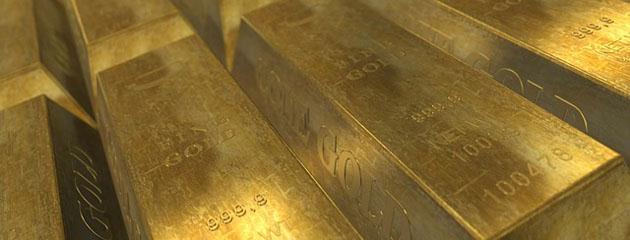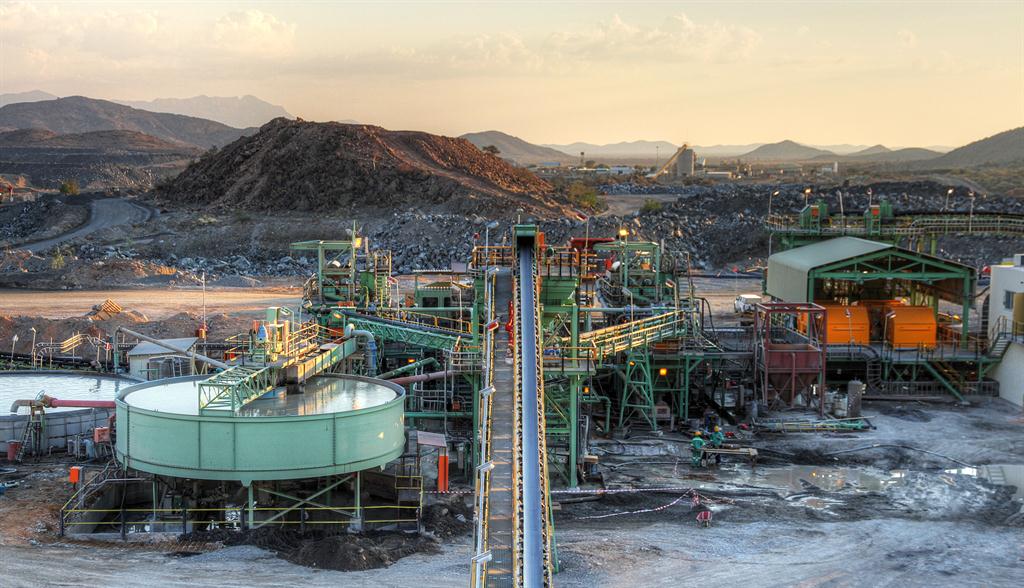Old gold hunt pays off
Gold production in Namibia has reached new heights after 120 years of prospecting.
AUGETTO GRAIG
The glowing flagship of Namibia’s gold production is the B2Gold Otjikoto Gold Mine between Otavi and Otjiwarongo, which recorded an output of 5 429 kg of gold bullion and 104 kg of silver in 2017. In the same year, the Navachab open-pit gold mine produced 1 843kg of gold. More recently, B2Gold reported that it produced 4744 kg of gold bullion last year, while it is continuing with exploration at its joint venture with Forsys Metals at Ondundu, just north of the Navachab gold mine.
The first gold discoveries in Namibia were made in 1899. Gold mining began in 1933 but was later abandoned. Today, gold mining is once again at the forefront of Namibian mining ambitions thanks to advances in modern technology, exploration and mining techniques.
According to Namibweb.com, the first gold-bearing quartz veins in Namibia were discovered in the Rehoboth district in Sinclair Sequence volcanogenic host rock. A highly speculative pegging boom took place on the Rehoboth gold fields during 1933 and 1934, and subsequently up to 1941, 199.2 kg of gold was produced from small oxidised and supergene-enriched deposits.
The 1917 discovery of the Ondundu gold field in the Omaruru District marked the first true Namibian “gold rush”. Mining of primarily alluvial deposits and some hard-rock mining produced 614.4 kg of gold until the mine’s closure in 1963.
During the period 1937 to 1943, alluvial gravels were worked in the Epako–Otjua area, Omaruru District, producing some 46.9 kg of gold. The commissioning of the Navachab Gold Mine in the Karibib District in 1989 was the result of an upswing in gold exploration that started in the early 1980s and continues today.
The current production of gold in Namibia dwarfs all previous production years. Up to the 1960s, approximately 662 kg of gold was produced from several small mines. Between 1965 and 1989 an additional 1 878 kg of gold was produced, mostly as by-product from base-metal mines.
Until the discovery of the gold-skarn deposit at Navachab, the only known primary gold mineralisation in Namibia was of the quartz vein type, with limited secondary development of alluvial deposits. Hydrothermal gold quartz veins with associated base metals occur at several localities within the Huab Complex and Khoabendus Group in the northwest of Namibia.
In the geologically similar volcano-sedimentary Sinclair and Rehoboth sequences, supergene enrichment through oxidation of auriferous hydrothermal sulphides has provided grades sufficient to support small-scale mining ventures.
The hydrothermal Ondundu gold deposits are Namibia’s prime example of disseminated gold mineralisation development with tourmalinisation, followed by enrichment within structurally controlled quartz vein systems. The marble-hosted gold-skarn at Navachab is related to multistage mineralisation in the Central Zone of the Damara Sequence.
These two principal styles of gold mineralisation are not the only types present in Namibia, according to the national geological survey. Among others, Nosib Group quartzites east of Sesfontein and near Opuwo contain gold-bearing quartz veins, while Swakop Group rocks host auriferous pegmatites. In addition, several types of base-metal mineralisation carry gold that can be extracted as a by-product. The Otjihase, Tsumeb and Kombat mines are examples of such base-metal ore bodies.
The Navachab gold deposit was discovered as a result of a geochemical exploration programme in October 1984 on the farm Navachab, 6 km south of the main Okahandja-Swakopmund tar road. An appraisal was done in 1986, followed by a feasibility study in 1987, after which a decision was made to proceed with the development of a mine.
Construction work began in 1988 and the first gold bar was poured 21 months later in December 1989, establishing Namibia as one of the world’s gold-producing countries. The mine was completed at a capital cost of N$85 million. The plant was commissioned in November, with full production achieved in January 1990.
The 35-metre-thick ore body is hosted in a thick marble unit. The ore body dips at 70' to the west and plunges at 14' to the north and it was initially mined by open-cast method to a depth of 160 metres.
QKR was established with funds from Qatar and Polish billionaire Jan Kulczyk by former JP Morgan banker Lloyd Pengilly to buy the mine from AngloGold Ashanti in 2014. The estimated life-of-mine expected that year was until 2028.
The Otjikoto gold mine was officially opened in 2015 with an expected life-of-mine of about 12.5 years. More recently established higher grade reserves discovered at the mine’s Wolfshag open pit may push activity at the mine beyond 2027. Production of this ore is expected to resume later this year, after completion of the expansion of the pit.
For 2019, the Otjikoto Mine is forecast to produce between 4677 kg and 4961 kg of gold, primarily from the Otjikoto Pit, although gold production is scheduled to be significantly weighted towards the second half of the year.
The glowing flagship of Namibia’s gold production is the B2Gold Otjikoto Gold Mine between Otavi and Otjiwarongo, which recorded an output of 5 429 kg of gold bullion and 104 kg of silver in 2017. In the same year, the Navachab open-pit gold mine produced 1 843kg of gold. More recently, B2Gold reported that it produced 4744 kg of gold bullion last year, while it is continuing with exploration at its joint venture with Forsys Metals at Ondundu, just north of the Navachab gold mine.
The first gold discoveries in Namibia were made in 1899. Gold mining began in 1933 but was later abandoned. Today, gold mining is once again at the forefront of Namibian mining ambitions thanks to advances in modern technology, exploration and mining techniques.
According to Namibweb.com, the first gold-bearing quartz veins in Namibia were discovered in the Rehoboth district in Sinclair Sequence volcanogenic host rock. A highly speculative pegging boom took place on the Rehoboth gold fields during 1933 and 1934, and subsequently up to 1941, 199.2 kg of gold was produced from small oxidised and supergene-enriched deposits.
The 1917 discovery of the Ondundu gold field in the Omaruru District marked the first true Namibian “gold rush”. Mining of primarily alluvial deposits and some hard-rock mining produced 614.4 kg of gold until the mine’s closure in 1963.
During the period 1937 to 1943, alluvial gravels were worked in the Epako–Otjua area, Omaruru District, producing some 46.9 kg of gold. The commissioning of the Navachab Gold Mine in the Karibib District in 1989 was the result of an upswing in gold exploration that started in the early 1980s and continues today.
The current production of gold in Namibia dwarfs all previous production years. Up to the 1960s, approximately 662 kg of gold was produced from several small mines. Between 1965 and 1989 an additional 1 878 kg of gold was produced, mostly as by-product from base-metal mines.
Until the discovery of the gold-skarn deposit at Navachab, the only known primary gold mineralisation in Namibia was of the quartz vein type, with limited secondary development of alluvial deposits. Hydrothermal gold quartz veins with associated base metals occur at several localities within the Huab Complex and Khoabendus Group in the northwest of Namibia.
In the geologically similar volcano-sedimentary Sinclair and Rehoboth sequences, supergene enrichment through oxidation of auriferous hydrothermal sulphides has provided grades sufficient to support small-scale mining ventures.
The hydrothermal Ondundu gold deposits are Namibia’s prime example of disseminated gold mineralisation development with tourmalinisation, followed by enrichment within structurally controlled quartz vein systems. The marble-hosted gold-skarn at Navachab is related to multistage mineralisation in the Central Zone of the Damara Sequence.
These two principal styles of gold mineralisation are not the only types present in Namibia, according to the national geological survey. Among others, Nosib Group quartzites east of Sesfontein and near Opuwo contain gold-bearing quartz veins, while Swakop Group rocks host auriferous pegmatites. In addition, several types of base-metal mineralisation carry gold that can be extracted as a by-product. The Otjihase, Tsumeb and Kombat mines are examples of such base-metal ore bodies.
The Navachab gold deposit was discovered as a result of a geochemical exploration programme in October 1984 on the farm Navachab, 6 km south of the main Okahandja-Swakopmund tar road. An appraisal was done in 1986, followed by a feasibility study in 1987, after which a decision was made to proceed with the development of a mine.
Construction work began in 1988 and the first gold bar was poured 21 months later in December 1989, establishing Namibia as one of the world’s gold-producing countries. The mine was completed at a capital cost of N$85 million. The plant was commissioned in November, with full production achieved in January 1990.
The 35-metre-thick ore body is hosted in a thick marble unit. The ore body dips at 70' to the west and plunges at 14' to the north and it was initially mined by open-cast method to a depth of 160 metres.
QKR was established with funds from Qatar and Polish billionaire Jan Kulczyk by former JP Morgan banker Lloyd Pengilly to buy the mine from AngloGold Ashanti in 2014. The estimated life-of-mine expected that year was until 2028.
The Otjikoto gold mine was officially opened in 2015 with an expected life-of-mine of about 12.5 years. More recently established higher grade reserves discovered at the mine’s Wolfshag open pit may push activity at the mine beyond 2027. Production of this ore is expected to resume later this year, after completion of the expansion of the pit.
For 2019, the Otjikoto Mine is forecast to produce between 4677 kg and 4961 kg of gold, primarily from the Otjikoto Pit, although gold production is scheduled to be significantly weighted towards the second half of the year.








Comments
Namibian Sun
No comments have been left on this article